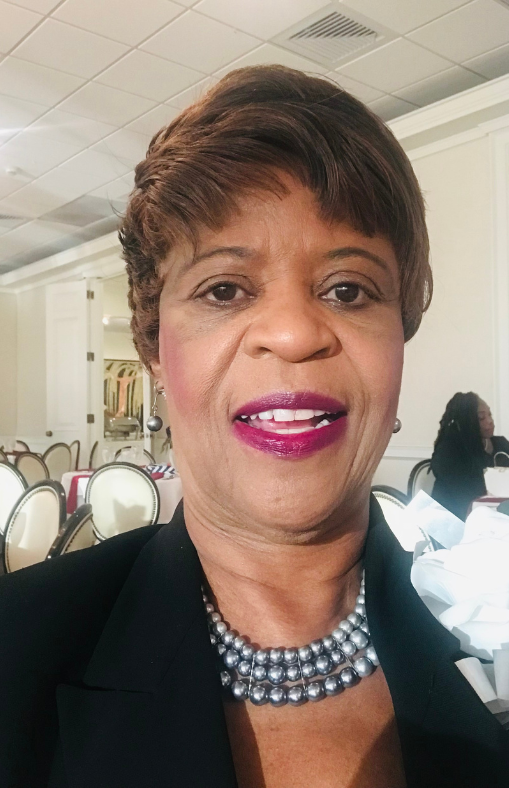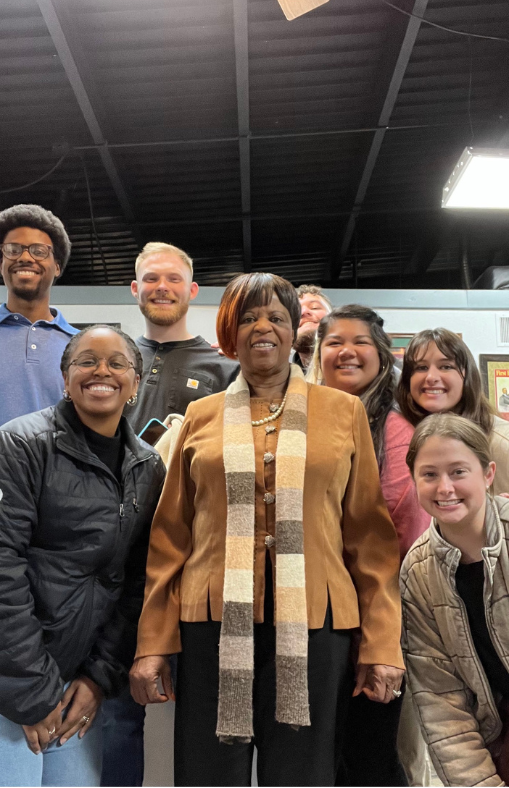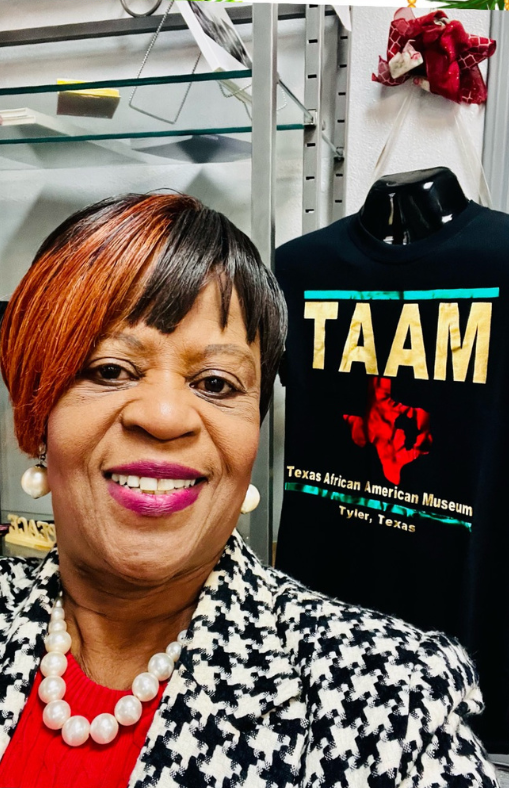
Jane: My guest today is Gloria Mays Washington. Gloria is a resident of Tyler, Texas, having lived here since 2008. She’s originally from Jasper, Texas. She’s a graduate of Angelina Junior College with an Associate’s Degree in Human Services and received her Bachelor’s Degree in Human Services from Stephen. F. Austin University. Gloria is the executive director of the Texas African American Museum in Tyler and a board member of the Empowerment Community Development Corporation. Welcome, Gloria Washington.
Gloria: Thank you.
Jane: I invited you to talk to The Tyler Loop because I would love to hear more about two things: One is the Texas African American Museum and the second is your experience as a woman growing up in Jasper, Texas, and now in Tyler. So please begin by talking to us more about the museum.
Gloria: Well, first of all, I’ve been the executive director at the Texas African American Museum since 2017. I have enjoyed this role, and I’m continuing to enjoy this role, because it’s based on our African American history dating back to when our ancestors were in the cotton fields. And now we are in an era where we are commencing with doctors, lawyers, dentists, educators — and we’re all on the same page, teaching and educating African American history, and I enjoy doing that. When I’m at the museum, I feel like my ancestors are there as well, telling me to keep telling the story. Just keep telling the story.
Jane: For someone who visits the Texas African American Museum, what can they expect to see and experience there?
Gloria: The Texas African American Museum consists of local individuals in the city of Tyler, Texas, who have contributed to our society as well as state, local, national and international. So you will see a different array of individuals, African Americans, not just African Americans, though. You will see other races there as well that have contributed to our society.
Jane: I got a grand tour, thanks to you, a few months ago.
Gloria: You’re welcome.
Jane: Are there any displays or exhibits that are especially meaningful to you?
Gloria: Yes, there are. I have a display. Dr. Martin Luther King Jr.’s birthday was this past Monday. So, I have a display of Dr. King. I have a display of a young lady here, she deceased now. She was an educator from Bullard. She educated here in the Smith County and Tyler, Texas area. But even during her working experience, she continued on as a volunteer at Trinity Mother Frances Hospital. So, at that age she retired, it gives me inspiration to want to keep going further.
So, we do have different displays there and we’re continuing to look forward to other displays. We have collaborated with the Tyler Independent School District to where, when the students are on a field trip, we are on the radar. They can come visit us, schedule a tour and come and visit the museum.
Jane: Wonderful. The museum recently changed locations and had a grand opening. Can you tell us where it’s located and how people attend?
Gloria: When we started out, we were on social media, and from social media, we obtained our first physical location. It was on Erwin Street. This proprietor had to leave suddenly, so we were scrambling, trying to find somewhere to go. We went to the old Mamie Griffin Elementary School. We were there for about two years. And through the inspiration of God — I’m saying God works through people — the City of Tyler gifted us a discarded fire station, fire station number 4. They gifted us that building, and we’ve been there since.
And we are located at 309 West Martin Luther King, Jr. Boulevard here in Tyler. And what an awesome location on Dr. Martin Luther King Jr. Boulevard: The Texas African American Museum. Yes, that’s where we are.
And you can contact us through (903) 283-6089. And we do have a website, texasafricanamericanmuseum.org.
Jane: Yes, and the new building is nice and an upgrade in space, and the exhibits look great.

Gloria: And one thing that dampened our spirit, dampened our outgoing aspect as far as seeking donations, because nonprofits never stop asking for donations, right? We’re a nonprofit and we always ask for donations. Back at our last gala in 2022, we were made a promise that never came through. We were promised a million dollars, and we never received that million dollars. And so now, we have to start the ball game all over again to try and get out there and secure funding so that we can keep going strong.
Jane: I see. I was especially interested in the exhibits at the museum that feature Black East Texans. Who might we be surprised to learn about?
Gloria: The great Mr. Earl Campbell. We do have a large photo of Earl Campbell when he was with the Houston Oilers. And that’s why I still love the Houston Texans is because of Earl Campbell. He’s local and he’s someone that you can put your hand on.
And I also have a autographed jersey from. Patrick Mahomes. Now that’s my boy, Pat. And I just heard this morning that he may be going back to the Super Bowl. So, we do have a display with his jersey.
Jane: Yeah, that’s great. Let’s talk about upcoming events. As 2023 rolls out, is there anything for people to attend or know about happening at the museum?
Gloria: Sure, we are open. I would like to say this: we are open on Thursday and Friday from 10 a.m. until 2 p.m. and Saturdays 10 a.m. until 4 p.m. So, come by and visit with us. Coming up February, which is Black History Month, we will be presenting our second annual Black History Gala. This gala is going to be held at Willowbrook Country Club here in Tyler. We have a great dynamic speaker who is a chemical engineer director at Goodyear tire plant. He’s out of Houston, but I have spoken to him the other day. He got an upgrade on his job duties. He’s not director down in Atlanta, Georgia.
So, he’s going to be our dynamic speaker and we are encouraging each and everyone to come out. And the time would be from starting at 6 o’lock. Tickets are $50 per person, or you can purchase a table that seats 10.
Jane: Okay, fantastic. I can see you’ve made this pitch before!
Let’s transition. I would love to hear about your growing up in Jasper, Texas. How has that informed you as a woman, a resident of East Texas and in the work you’re doing now?
Gloria: Yes, I grew up in a little, small town called Jasper, Texas. When I was growing up, we were segregated. African American students, children, were at one school and the Caucasian students were at another school, so we never mixed together other than my mother was a household technician, if you know what that is.
Jane: Yes.
Gloria: And to this day, if I go back to Jasper, they know me from my dad, Sherrion Beaty. “That’s Sherrion’s daughter.” And we just grew up together. But now, that was in one aspect. But when we were to go downtown, it’s as if it was colored only or white only or whatever. We did have those segregated lines for sure.
Our books were handed down from the Caucasian school. Some of the pages were torn out, some of the pages were good. If you happened to get a good book, you were to the good, but if you didn’t, the teacher had to explain to you what you were missing. But all of that changed.
So, a lot of people say that they have difficulties with Caucasian races of people. I can’t say that. They were good to my dad, and if my dad was still lliving today, he would still have the same opinion. They were good to him.
Jane: So, it’s that mixed bag where you have a positive experience, maybe with an individual or a family, but you’re still living in a world where things are wildly unequal.
Gloria: Yes, yes. But I contributed all to God that he has brought me from the location of Jasper, Texas, to Tyler, Texas. We still have the same group of people that we encounter with every day, but I think from 1968, 69, we have grown closer.
We have developed more of the same ideas. Everyone is equal. We can walk up and we can shake hands with each other. We can give each other hugs.
As I looked at the Martin Luther King March the other day, we had a different variety of races and everybody really got along well, and that’s what I hoped to see: that one day we can all realize we are all humans. We’re all God’s children and we have got to get together. We’ve got to get along or we are going to be lost.
We have young children that’s coming on behind us. We don’t want that same disparity to be involved in their life as what has been going on in the lives of we older elders.

Jane: I noticed you mentioned the years 68 and 69. Why are those prominent in your thinking as a turning point?
Gloria: As a turning point, because it ended segregation, and we all became integrated. The schools became integrated. We could go to the same schools, we could drink out of the same fountain, we could eat at the same restaurants. So, that was a turning point.
Jane: So, when I learned that you were from Jasper, Texas, really my first knowledge of Jasper was, of course, the massacres that happened there. Was that something you knew about growing up and talked about with others?
Gloria: Well, we had atrocities that occurred in Jasper, Texas, but, you know, we made our way through it. But when the atrocity happened to James Byrd, Jr., now that opened a different kind of worms. Everybody began to get shy for everyone else.
Everyone thought everyone else was going to do harm, do damage or whatever. But we got through that, and we came to realize that the atrocity was gang-related. They were trying to initiate these young guys that did the killing. They were trying to get them initiated into the Arian Brothers Nation. That was one of their tasks that they had to do, was to kill a Black man. And they killed this Black man because he could not defend himself. He was in a drunken state and he could not defend himself. But thank goodness there was someone that saw the atrocity from the start, and they informed the police, but they were able to get all three of the individuals involved in the atrocity.
But, we got through that. I always tell everyone I give thanks to one young man that was from Jasper, Texas, and he’s still here in Tyler, Texas, and he worked for the sheriff’s department. His name was Bobby Garmon. And Bobby is still here. Every day, Smith County would send their patrol down to Jasper to help with the crowds. So, every day, I would see the Smith County patrol come to Jasper. I felt comfortable, because I know Bobby Garmon on the way. Bobby would take care of us and today we are still friends.
Jane: It’s a good feeling to know you have that ally with someone who can help.
Gloria: Yes.
Jane: You know, we were on a Zoom call earlier this week and with Martin Luther King Jr. Day coming up, you mentioned that you remember well that time of civil rights in the late 50s, early 60s — well, in East Texas, it was more like late 60s, early 70s.

What kind of time was that in East Texas? What did you experience during those MLK years that were so potent to our nation?
Gloria: Some African American homes did have television, and when that atrocity happened with Dr. King, everyone’s eyes were glued to the television. We wanted to know exactly what was going on, and we wanted to know why something like that would’ve happened to a God-fearing man, someone that was trying to help make our society better.
There was always talk, there was always speculation, but we got through it. I remember when Dr. King was assassinated. I was in high school.
Jane: So this was 1968?
Gloria: Yes. It was a solemn day, because who would think someone would do an atrocity like that? So it created a coming together in the religious aspects.
So, everyone came together to do prayer to consider he and his family. So there was a coming together, and that’s what I remember.
Jane: Before Dr. King’s assassination, were you and your peers already well aware of the marches and the boycotts happening?
Gloria: Yes, we were. And on that note, after I got married, I started the Martin Luther King march in Jasper, Texas.
Jane: You did?
Gloria: Yes, I did. It was a freezing cold day. But, we got in started and after I got the march started, the NAACP came in and started working with me to keep it going, keep it going. And so, we had a great parade, all the way downtown to a school that used to be the high school where I graduated from. And businesses supported, individuals supported. So, I feel a closeness to any Martin Luther King march because I, in my heart, I know I started the first one in my little town.
Jane: Oh my goodness. That’s so revealing for the work you’re doing now.
Is there anything else that hasn’t come up yet that’s important for you to share?
Gloria: Right now, that the Texas African American Museum, we do not have a fee to come to the museum. We operate on donations if anyone wants to leave a donation. But we are contemplating the idea of having admission fees. It’s not anything major, it’s just something small. And so we want everyone that will help us on trying to secure funding from different federal sites, federal organizations, state organizations. We have to show that we are trying to be self-sufficient.
So, if you would like to make a donation to the Texas African American Museum, we are a 501C3 nonprofit organization, we you can use it as a tax deduction at the end of the year. But I just want to let you know we are a nonprofit and we are under the auspices of Empowerment Community Development Corporation.
Jane: Fantastic. Thank you. Thank you so much for your time today, Gloria.
Gloria: Oh, thank you. I have enjoyed it.
Love what you're seeing in our posts? Help power our local, nonprofit journalism platform — from in-depth reads, to freelance training, to COVID Stories videos, to intimate portraits of East Texans through storytelling.
Our readers have told us they want to better understand this place we all call home, from Tyler's north-south divide to our city's changing demographics. What systemic issues need attention? What are are greatest concerns and hopes? What matters most to Tylerites and East Texans?
Help us create more informed, more connected, more engaged Tyler. Help us continue providing no paywall, free access posts. Become a member today. Your $15/month contribution drives our work.







